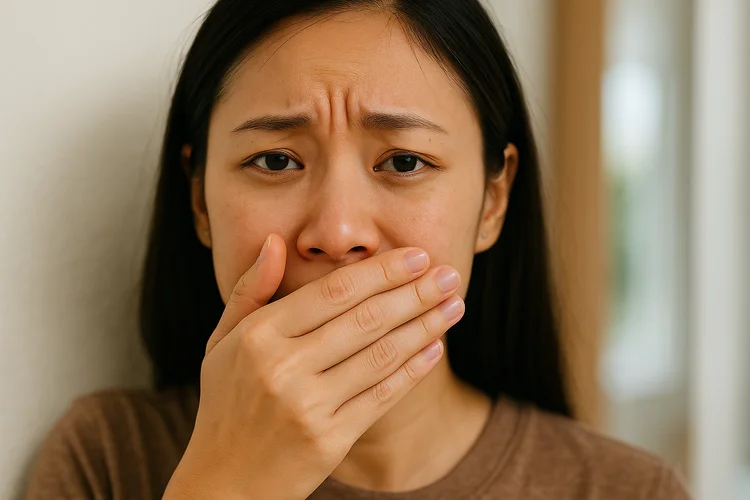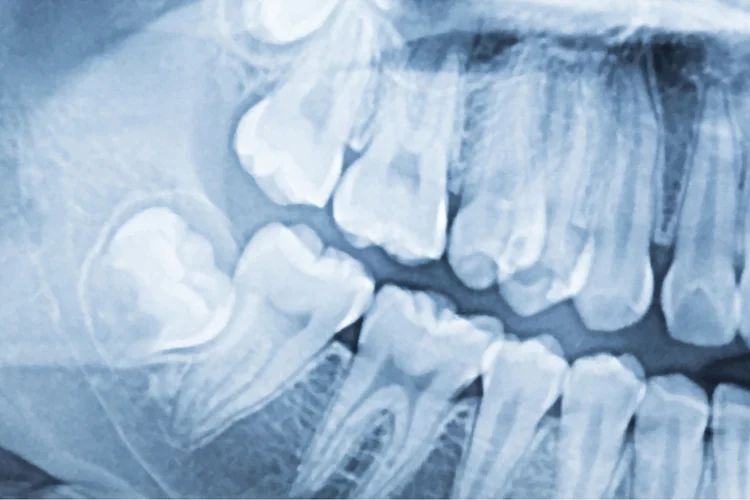What Is Teeth Crowding?
Teeth crowding happens when there is insufficient space in the jaw
for teeth to emerge or align properly, leading to overlapping, twisting,
or displacement of teeth. This condition, also called dental
crowding, is a type of malocclusion (bite misalignment) and can impact both
the appearance and function of your teeth.
The degree of crowding can vary from mild misalignment to more significant
overlapping. It may involve the upper jaw, lower jaw, or both.
Crowded teeth can be more challenging to clean thoroughly, which can
raise the risk of tooth decay, gum disease, and other oral health
issues. Getting appropriate treatment for teeth crowding early
on can help prevent problems and support your long-term oral health.

What Causes Crowded Teeth?
Crowded teeth can develop due to a combination of genetic, developmental and environmental factors. Common causes include:
- Jaw size discrepancy – If the upper jaw is too small, especially at the front, there may not be enough room for all the permanent teeth to erupt properly. This can lead to crowding in the upper or lower teeth, or both.
- Early or late loss of baby teeth – Disruption to the normal eruption sequence can cause neighbouring teeth to shift out of position, resulting in malalignment.
- Extra or unusually large teeth – Oversized or supernumerary teeth (hyperdontia) can take up additional space in the jaw, displacing neighbouring teeth and increasing the risk of crowding.
- Thumb-sucking or prolonged pacifier use – These parafunctional habits (non-functional actions not related to eating or speaking) can affect how teeth erupt and align. When prolonged beyond early childhood, they are associated with bite problems, such as front teeth that do not meet or back teeth that fail to align properly.
- Orofacial Myofunctional Disorders (OMDs) – Conditions affecting tongue posture, breathing or muscle activity around the mouth can contribute to long-term changes in jaw growth and tooth position.
Why Should Crowded Teeth Be Treated?
Untreated crowded teeth can lead to both functional and oral health complications. Some of the key concerns include:
- Oral hygiene difficulties – Tight spacing can make brushing and flossing less effective, allowing plaque to accumulate in hard-to-reach areas.
- Tooth decay and gum disease – Plaque build-up increases the risk of dental caries and gingivitis.
- Aesthetic concerns – Crowded teeth can look uneven or misaligned, affecting the appearance of your smile and contributing to self-consciousness or low self-esteem.
- Excessive tooth wear – Malocclusion can create uneven pressure on certain teeth, leading to premature wear.
- Jaw pain or dysfunction – In more severe cases, crowding may affect jaw alignment and contribute to temporomandibular joint (TMJ) discomfort.

How Can You Tell if Your Teeth Are Crowded?
Crowded teeth often present as visible overlapping, rotation or teeth that appear pushed forward or backward in the dental arch. Other common signs include:
- Difficulty flossing between certain teeth.
- Increased plaque build-up due to tight spacing.
- Jaw discomfort or bite irregularities.
- Speech changes or lisping in some cases.
How Are Crowded Teeth Diagnosed?
Crowded teeth are typically diagnosed by a dentist through a combination of clinical examination and diagnostic tools. These may include:
- Visual inspection to assess the position and alignment of the teeth.
- Dental X-rays to evaluate root positioning, spacing and the condition of the jawbone.
- Bite analysis to identify any functional issues related to occlusion or jaw alignment.
- Intraoral scans or impressions to produce 3D models for precise treatment planning.

What Are the Treatment Options for Crowded Teeth?
The approach to treating crowded teeth varies based on how misaligned they are, the patient's age, and overall oral health. Typical treatment options include:
| Treatment | Description |
|---|---|
| Braces |
Fixed orthodontic appliances that use brackets and wires to apply gradual,
continuous pressure on the teeth.
|
| Clear Aligners |
Custom-made, removable plastic trays, such as Invisalign® designed to reposition
teeth over time.
|
| Tooth Extraction |
Removal of one or more teeth to create additional space in the jaw.
|
| Palatal Expanders |
Devices used mainly in children or adolescents to widen the upper jaw to
create more space for permanent teeth to erupt in proper alignment.
|
Crowded Teeth Treatment Cost
At True Dental Studio, we offer clear aligner treatment using Invisalign, as well as tooth extraction where needed, to manage overcrowded teeth. Our prices are as follows:
| Treatment | Price* |
|---|---|
| Consultation | $27.25 to $65.40 |
| Milk Tooth Extraction | $49.05 to $98.10 |
| Adult Tooth Extraction | $98.10 to $272.50 |
| Invisalign / Invisible Braces | $3,924 to $9,810^ |
*Prices are NETT and inclusive of GST.
^Medium-complexity cases generally range from $5995* to $7085*. Prices
vary based on complexity and may exceed the stated amount. All patients are
subjected to an initial assessment.
When Should You Seek Treatment for Crowded Teeth?
You should consider seeking a dental evaluation if you notice any of the following:
- Visibly overlapping or rotated teeth
- Difficulty maintaining oral hygiene
- Jaw discomfort, clicking or bite irregularities
- Concerns about the appearance of your smile
Early diagnosis can simplify treatment, prevent the progression of crowding and reduce the risk of long-term oral health complications.
Book a Consultation With Our Friendly Dentists Today!
Book Dental Appointment
Book NowEnquire More Through Email
Email Us NowEnquire More Through WhatsApp
WhatsApp Us NowWhy Choose True Dental Studio?
Friendly Dentist and Team
Our team treats each and every patient to the best of our ability. This is the reason why entire families have continued their dental care with True Dental Studio for many years, from all over Singapore.
Minimal Discomfort
At True Dental, it is our commitment to ensure our patients are kept as comfortable as possible. We aim to minimize discomfort, if any, for our patients.
Affordable Treatments
We believe in pricing quality treatments at a competitive rate. We are transparent and upfront with our treatment costs.
Our Smile Scorecard
Frequently Asked Questions
Invisalign can typically be used to treat mild to moderate crowded teeth by gradually shifting them into better alignment using custom-made clear plastic trays. These aligners apply controlled pressure to guide teeth into their proper positions over time. Braces may be recommended instead for more complex or severe crowding that requires greater control of tooth movement. Consulting a dentist for a proper evaluation can help determine if Invisalign is suitable for your case.
Treatment for lower teeth crowding may include braces, clear aligners, or tooth extraction, depending on the severity and underlying cause. Braces and aligners reposition the teeth over time, while extraction may be recommended if there is insufficient space in the jaw. In growing patients, expanders may also be used to modify jaw development. Consulting a dentist or orthodontist can help assess your condition and determine the most appropriate treatment option.
Veneers do not correct the position of crowded teeth but may be used to mask minor irregularities in shape or alignment for aesthetic purposes. They involve reshaping the natural teeth and placing thin shells over the surface to improve appearance. However, veneers do not address the functional issues or oral health risks associated with true dental crowding. Consulting a dentist can help you explore whether veneers or orthodontic treatment is more appropriate for your goals.
Braces treat crowded teeth by applying continuous pressure through brackets and wires to gradually shift the teeth into proper alignment. This process can take 18 months or longer, depending on the severity of crowding and the treatment plan. In some cases, braces may be combined with extractions or expanders to create sufficient space. It is best to consult a dentist or orthodontist to help determine if braces are suitable for your needs.
Crowded teeth can cause discomfort due to pressure between teeth, difficulty maintaining oral hygiene, or malocclusion. In some cases, this may lead to jaw pain, tooth sensitivity, or gum irritation. Pain may also arise if crowding results in tooth wear or temporomandibular joint (TMJ) strain. If you are experiencing persistent or worsening tooth, gum or jaw pain, it is best to consult a dentist for a proper evaluation to determine the cause of pain and appropriate treatment.
Overcrowded teeth are typically treated with orthodontic options such as braces or clear aligners, and in some cases, tooth extraction may be required to create space. Early intervention in children may involve expanders to guide jaw development. The right treatment depends on the severity, age, and overall oral health. Consulting a dentist or orthodontist can help determine the most appropriate and effective approach for your situation.
Crowded teeth cannot be fully corrected naturally once permanent teeth have erupted, as tooth position is influenced by jaw structure and spacing. While maintaining good oral habits may reduce the risk of worsening crowding, professional orthodontic intervention is typically required to realign teeth. In children, early habit correction and jaw development monitoring may help mitigate future crowding. Consulting a dentist or orthodontist can help determine if treatment is needed based on your dental condition.
Crowded teeth do not always need to be removed, but tooth extraction may be recommended if there is insufficient space in the jaw for proper alignment. Extraction is typically considered when severe crowding prevents orthodontic appliances from repositioning teeth effectively. In milder cases, braces or clear aligners may be used without removing any teeth. Consulting a dentist or orthodontist can help determine whether tooth removal is required for your treatment plan.
Crowded teeth may become more pronounced with age due to natural changes in the jaw, tooth movement, and wear. Factors such as late wisdom tooth eruption, gum recession, or loss of supporting bone can contribute to worsening alignment over time. Early diagnosis and treatment can help prevent complications and reduce the extent of correction needed. If you notice shifting teeth or increasing crowding, it is best to consult your dentist to assess whether treatment is needed.
Most adults have 32 permanent teeth, including wisdom teeth. Having more than this is known as hyperdontia and may contribute to crowding or misalignment. Not all extra teeth require removal, but treatment may be needed if they affect eruption, spacing, or function. A clinical examination and dental imaging are necessary to assess their impact. Consulting a dentist can help determine whether additional teeth are affecting your oral health.
There is no direct evidence that vitamin deficiency causes dental crowding, but poor nutrition during early development may influence jaw growth and tooth eruption patterns. Deficiencies in vitamins D and A, for example, may affect bone and tooth formation, potentially contributing to spacing or developmental issues. However, most cases of crowding are primarily due to genetic and developmental factors.
